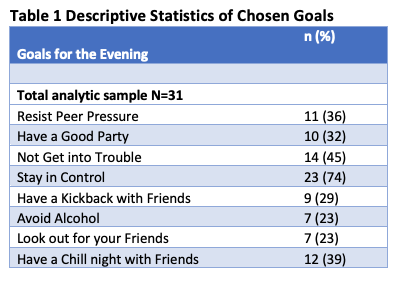Public Health & Prevention
Category: Abstract Submission
Public Health & Prevention III
491 - Alcohol use and in-game goals and behavioral choices in a narrative-centered behavior change environment for reducing risky alcohol use
Sunday, April 24, 2022
3:30 PM - 6:00 PM US MT
Poster Number: 491
Marianne Pugatch, University of California, San Francisco, School of Medicine, Watertown, MA, United States; Alison Giovanelli, University of California, San Francisco, School of Medicine, San Francisco, CA, United States; Mark Berna, University of Calfornia San Francisco, San Carlos, CA, United States; Jonathan Rowe, North Carolina State University, Raleigh, NC, United States; Megan Mott, University of North Carolina at Chapel Hill, Chapel Hill, NC, United States; Kathleen P. Tebb, University of California, San Francisco, School of Medicine, San Francisco, CA, United States; Carlos Penilla, University of California, San Francisco, School of Medicine, San Francisco, CA, United States; Elizabeth Ozer, University of California, San Francisco, San Francisco, CA, United States

Marianne Pugatch, PhD, MSW
Postdoctoral Fellow
University of California, San Francisco, School of Medicine
Watertown, Massachusetts, United States
Presenting Author(s)
Background: Alcohol use is a leading cause of adolescent morbidity and mortality. INSPIRE is a game-based narrative-centered behavior change environment that is based in Social Cognitive Theory with the goal of promoting self-regulation and self-efficacy in making decisions to reduce risky alcohol use. INSPIRE holds promise to expand the delivery of alcohol risk prevention for adolescents in primary care settings. At the start of the INSPIRE game, adolescents set goals for the protagonist for the evening (Table 1). As an active participant in an unfolding story, players make choices for the protagonist about engaging with drinking alcohol in a house party scenario.
Objective: This exploratory study integrates trace log and self-report data to examine the relationship between adolescents’ in-game goals, in-game behavioral choices, and self-reported real-world alcohol use during the past 12 months.
Design/Methods: Pilot tests were conducted with 31 adolescents ages 14-17 years (2018-2020). Adolescents completed a survey that included questions about real-world alcohol use, and they interacted with INSPIRE. A team of experts developed clusters of adolescents’ in-game goals based on a conceptual model of risk reduction and social goals (Figure 1). Fisher’s Exact and Wilcoxon Rank-Sum tests were run to look at how consistently adolescents reported meeting their goals and how this related to both real-world alcohol use and in-game behavioral choices about drinking.
Results: Adolescent mean age was 15.7 years; 58% were female, and 48% were non-white, from nine distinct race-ethnicities. The rate of past 12-month real-world alcohol use was 45% and in-game drinking was 32%. While 97% of adolescents chose at least one risk reduction goal, 71% chose at least one social goal. Adolescents who engaged with in-game drinking chose fewer risk-reduction goals (z=2.78, p< .01) and more social goals (z=-2.78, p< .01). Adolescents who accepted in-game alcohol made fewer choices aligned with their chosen goals (z=3.39, p< .001). Those who endorsed real-world past 12-month alcohol use also made fewer choices aligned with their goals in the game (z=2.00, p< .05). Conclusion(s): Adolescents who reported using alcohol in real life and those who chose alcohol within the game were less likely to make choices that aligned with their in-game goals for the evening. This suggests that alcohol use choices may be related to self-regulation within INSPIRE with regard to consistency in pursuing in-game goals. Future work will further examine this finding as well as the relationship between in-game choices and real-world alcohol behavior.
Descriptive Statistics of Chosen Goals
Conceptually-based Goal Clusters.png)
Objective: This exploratory study integrates trace log and self-report data to examine the relationship between adolescents’ in-game goals, in-game behavioral choices, and self-reported real-world alcohol use during the past 12 months.
Design/Methods: Pilot tests were conducted with 31 adolescents ages 14-17 years (2018-2020). Adolescents completed a survey that included questions about real-world alcohol use, and they interacted with INSPIRE. A team of experts developed clusters of adolescents’ in-game goals based on a conceptual model of risk reduction and social goals (Figure 1). Fisher’s Exact and Wilcoxon Rank-Sum tests were run to look at how consistently adolescents reported meeting their goals and how this related to both real-world alcohol use and in-game behavioral choices about drinking.
Results: Adolescent mean age was 15.7 years; 58% were female, and 48% were non-white, from nine distinct race-ethnicities. The rate of past 12-month real-world alcohol use was 45% and in-game drinking was 32%. While 97% of adolescents chose at least one risk reduction goal, 71% chose at least one social goal. Adolescents who engaged with in-game drinking chose fewer risk-reduction goals (z=2.78, p< .01) and more social goals (z=-2.78, p< .01). Adolescents who accepted in-game alcohol made fewer choices aligned with their chosen goals (z=3.39, p< .001). Those who endorsed real-world past 12-month alcohol use also made fewer choices aligned with their goals in the game (z=2.00, p< .05). Conclusion(s): Adolescents who reported using alcohol in real life and those who chose alcohol within the game were less likely to make choices that aligned with their in-game goals for the evening. This suggests that alcohol use choices may be related to self-regulation within INSPIRE with regard to consistency in pursuing in-game goals. Future work will further examine this finding as well as the relationship between in-game choices and real-world alcohol behavior.
Descriptive Statistics of Chosen Goals

Conceptually-based Goal Clusters
.png)
